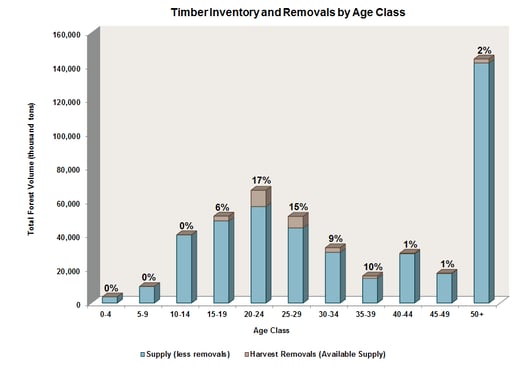
The need to distinguish total forest inventory from commercially-available inventory is crucial to accurately understand current and future supply. Insight into the volume of commercially-available inventory is gained through the analysis of forest inventory (supply) and the percentage of harvest removals per age class.
Consider, for example, an analysis of total forest volume by age class for a hypothetical wood supply region. The graph below shows approximately one-third of the total timber volume (supply) in the wood basin is mature timber 50 years or older. Based on this information, one might conclude that an abundant supply exists in this age class.

Further investigation into harvest removals reveals only two percent of timber in the 50+ age class is harvested each year. These removals account for nine percent of the annual harvest. Meanwhile, other age classes account for much less timber volume but have higher removal rates and yield more timber.
Why is so little of the total supply in the 50+ age class not made available to the market? Harvest constraints such as wet terrain are one obstacle. It is difficult to operate harvesting equipment near river bottoms and swamps, so most trees in these low ground areas typically grow to maturity (50 years or older). These trees are never harvested and eventually die naturally. Although data may show this inventory as available, this does not necessarily mean it is available commercially.
Ownership objectives also dictate timber harvests. Wood fiber is sold by both small, individual landowners and large organizations, each with a wide variety of ownership objectives that affect harvest timing and harvest type. Wood feedstock availability is closely tied to these ownership objectives.
The pine sawtimber market is one such example. When pine sawtimber commands a premium price per ton, corporate owners – TIMOs and REITs specifically – manage their timber to produce this higher value material and maximize return on timberland investments.
Unlike corporate owners, NIPF landowners are more flexible with respect to the timing and strategy of their timber harvests. Because private landowners harvest their trees just once or twice during their lifetime - typically to fund an expense such as a child’s college education or their own retirement - it is Forest2Market’s opinion that they are price conscious and may delay timber harvests until they perceive prices are “high”.





